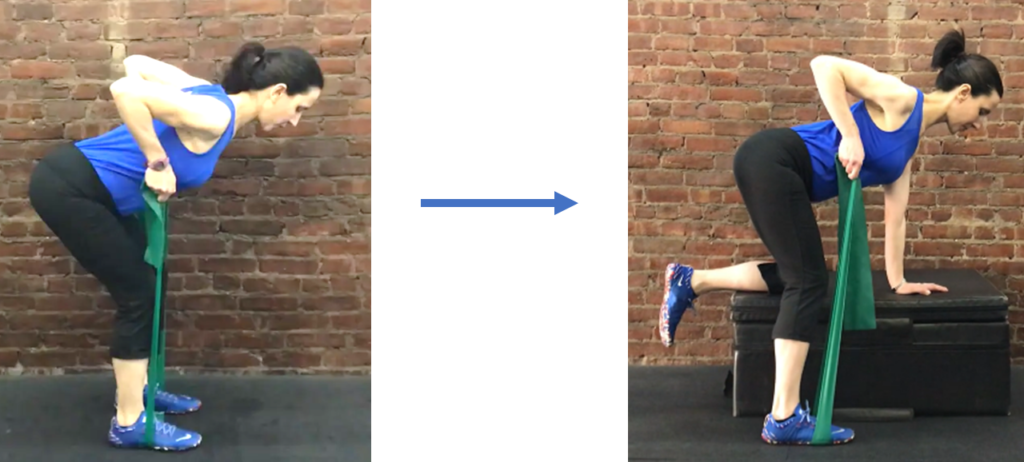Low Back Pain (LBP) is the #1 most common discomfort during pregnancy. In fact, close to 70% of people develop LBP at some point during pregnancy (Wang et al., 2004). It’s so common that it may seem inevitable. However, by understanding its causes, you will be better positioned to adjust certain habits in order to minimize its effects (or perhaps avoid it altogether).
Let’s first discuss why LBP is so common during pregnancy. Then, we will cover 7 key exercises to help you mitigate pain, along with some positions and activities to avoid to ensure you don’t aggravate pain.
Why is LBP so common during pregnancy?
The reason for its ubiquity is that there are several physiological and biomechanical factors that coalesce all around the same time, creating the conditions for LBP to thrive. Here are some of the key contributors:
- Alignment Changes: One of the biggest causes of LBP is the alignment shift created from your growing belly tipping your pelvis downward, pulling your lower back into an excessive arch (as in the image below). This position compresses the tissues in the lower back, making them tight and uncomfortable.

- Shift in Center of Gravity: The other “fun” side effect of your growing belly is that it actually shifts your center of gravity (which is normally about 2″ below your navel) up and out. When this happens, the muscles in the back of your body have to work harder to prevent you from falling forward. So, they are in constant tension. In addition, the extra weight in front often leads people to compensate by leaning backward to better balance themselves (like the image below), which can further accentuate the pressure on the lower back.

- Hormonal Changes: During pregnancy, there is an increase in a hormone called relaxin. As its name indicates, relaxin is responsible for a softening of all the soft tissues in the body. The purpose is to allow the pelvis to widen to adapt to the growing baby and to facilitate an easier labor. However, the down side of this pelvic loosening is that it decreases stability in this region, making it more difficult to resist the shift in center of gravity.
- A Stressed Core: As your baby grows, your belly stretches — lengthening the many layers of your abdominal muscles. This increased length, combined with the suboptimal position of the excessive low back arch (mentioned above), makes it harder for your core muscles to do their critical job of resisting getting pulled out of neutral alignment. As weight gain and alignment shifts increase, it can exceed the core’s capacity to cope. Furthermore, the excessive low back arch reduces the activation of the glutes, which are critical to providing support for the core and the low back muscles. With all these factors in play, LBP is in a position to thrive.
- Fatigue/Exhaustion: This can lead to longer periods of sitting — and slouching — which places added pressure on the low back.
7 Exercises to Focus On to Mitigate Pain
Now that you understand the contributing factors that can lead to LBP, it’s time to focus on the things you can do to help support your body to minimize, or prevent, the effects of LBP. Practice the 7 important exercises below.
- Find Neutral Alignment: OK, so this first one is not technically an “exercise,” but it is the most important tip to focus on to minimize LBP. It has to do with getting your body into neutral alignment to minimize pressure on your low back. Watch the video below to learn how to get your body into neutral alignment, and try to keep this in mind as you go about your day — especially during long periods of standing or walking.
- 360° Breathing: The deep core muscles and glutes help to stabilize the spine and pelvis. Strong core and glute muscles can help resist the alignment shifts that pull the lower back into the excessive arch. Begin by mastering what we call the #1 most effective core exercise: 360° Breathing. This simple movement activates your deep core muscles and gets them to work together in harmony. Practice it alone first, then learn how to incorporate it into your movements, as discussed in the demo below.
- Cat-Cow: This is a great mobility exercise to relieve tension in the low back. However, a common mistake is to focus more of the movement in the upper back, which doesn’t provide as much of that needed stretch to the low back. Watch the video demonstration below, which shows you how to initiate the movement from your pelvis to increase the release in your low back.
- Quadruped T-Spine Stretch: Another factor that can cause tightness in your low back is when adjacent areas of your body — like your hips and thoracic spine — are tight, and therefore move less than they are supposed to. When this happens, your low back often overcompensates during movements (meaning, more stress on your low back). Therefore, exercises #4 – 6 are designed to release these adjacent areas to help alleviate stress from your low back. This quadruped t-spine stretch helps to mobilize your thoracic spine.
- Kneeling Hip Flexor Stretch: Your hip flexors are another adjacent area that can increase tension in the low back if they are tight. Therefore, this hip flexor stretch is a great way to keep your hip flexors supple to ease tension in your low back.
- Windshield Wipers: This is a great hip mobility exercise to avoid placing excess stress on your low back.
- Bridge: As mentioned in exercise #2 above, strong core and glute muscles are essential for minimizing low back pain. The bridge is a great exercise to strengthen your glutes, and it’s safe to perform throughout pregnancy. Even though it involves lying on your back, you are moving the entire time, so it is perfectly safe.
We hope these exercises help you to feel some relief. If your pain is severe, you might also consider seeking a prenatal certified acupuncturist or massage therapist. Having another pair of helping hands can go a long way towards bringing relief to a body working hard to grow a little one.
What to Avoid
As you focus on the exercises above to bring relief, you’ll also want to avoid positions or conditions that provoke pain, such as the following:
- “Anti-Extension” Exercises: Anti-extension moves are core exercises that involve resisting getting pulled into extension — think planks and dead bugs. These moves can sometimes be too much for those already experiencing LBP. So, if you are experiencing pain, avoid these types of movements until you are asymptomatic.
- Moves that “ask a lot” of your core: Similar to the point above, if you are experiencing pain, avoid moves that require a lot of core work. For example, on the left image below, you can see a two-arm bent over row requires quite a bit of core work to hold that position. You can modify this to a kneeling row, as you see in the image on the right, using the other arm to support your body’s weight. This significantly reduces the load on the low back.

- “Lower” your weights: We mean this in two ways. First, lowering (or reducing) the amount of weight you lift is a great strategy to relieve some of the work from your low back. In addition, you can also lower the position of your weight. For example, when doing squats with a set of dumbbells, you could hold the weights down by your sides, as opposed to holding them in a racked position in front or your chest. As a rule of thumb, the higher you lift a weight above you, the more your core (or low back) will have to work.
- Avoid Provocative Positions: This one is obvious but worth mentioning. If something hurts, don’t do it. Even if you think you should fight through discomfort for the long-term benefit of doing certain activities, don’t.
Additional Support
- If you have painful symptoms, consider wearing a compression garment. We love the range from SRC Health, which offers high-quality garments to wear under and over your bump (use code PRONATAL10 for 10% off).
- For programs and services to help you exercise safely and effectively during pregnancy, check out our training programs & services.
- If you are a health & fitness pro interested in coaching pre & postnatal clients, explore our ProNatal Education & Certification.
Sources:
Wang, S., Dezinno, P., Maranets, I. Berman, M.R., Caldwell-Andrews, A.A., Kain, Z.N. (2004). Low Back Pain During Pregnancy. Obstetrics & Gynecology. 104(1), 65-70.
Affiliate Notification: The post contains an affiliate link for SRC health. We may earn a commission from purchases made through this link. However, we only endorse companies that we have personally vetted and believe in.
